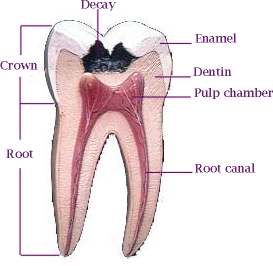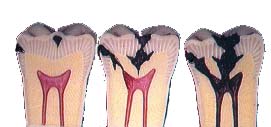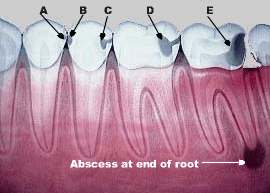

| Endodontics is the area of dentistry dealing with the prevention, diagnosis, and treatment of disorders of the dental pulp. Endodontic therapy (root canal) is a treatment modality that will save diseased or injured teeth. The alternative to endodontics is extraction. Typically, a severely decayed tooth or a tooth with a large filling will begin to ache. The pain might be intermittent at first and over time progress to a constant dull throbbing pain or a severe ache that might be felt on all the teeth on the affected side. Sometimes there is no pain and an abscess might be discovered on a routine x-ray. The pulp is the soft tissue that is located inside the tooth structure. It contains nerves, arteries, veins, and lymph tissue. It is contained in the canals located in thin tube-like spaces in the roots and in the pulp chamber located within the crown of the tooth.
| |

| |
 This image shows how the progression of decay, if not treated, will lead to destruction of the tooth's hard tissue and pulp. If treated at the beginning of the decay process (first image), a small filling would resolve the problem. If allowed to continue as in the last image, root canal therapy would be necessary. | |
 Decay progressing from a white spot lesion(A), into the enamel(B), into the dentin(C), towards the pulp(D), into the pulp(E), resulting in the formation of an abscess in the jaw bone. | |
| When the pulp is diseased or injured and unable to repair itself, it becomes infected. Left untreated, the pulp will die and become necrotic. Pus can build up at the root tip, forming an abscess that can destroy the bone surrounding the tooth. Endodontic treatment is the removal of the diseased pulp tissue, which will enable the body's defense system to repair the damage caused by the infection. Endodontic therapy normally takes two or three visits to complete. The following steps are involved in the treatment of the tooth:
| |
 The dark area at the end of the root is a large abscess before endodontic treatment. |
 This shows the healed abscess after endodontic treatment. |
| Following completion the tooth will need to be restored. Due to the large amount of tooth structure usually lost from decay and old fillings the preferred restoration is a crown. A post may be placed into the root to give additional structural support. | |
| Bonding | Veneers | Crowns | Bleaching | Recontouring | Periodontal Disease | Fluoride | Sealants | Prevention | Tooth Topics | History | Children | Endodontics | Materials | TMD | FAQ | Prosthodontics | Implants |
